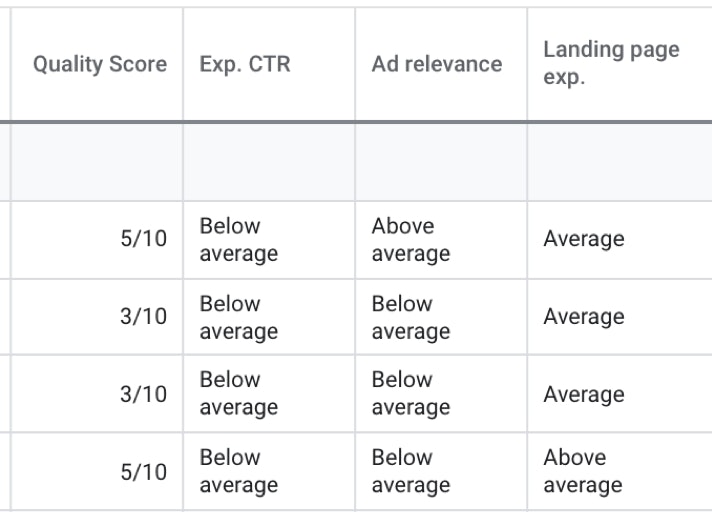A common novice mistake is to get tripped up on your search campaign’s quality score. Yes, higher quality scores have been correlated with lower costs and higher ranks in the auction, but your quality score should never be one of your main KPIs because it’s essentially an estimate. It is more of a helpful tool to help guide decision-making when it comes to paid search optimizations.
What is a quality score?
Google summarizes quality score as “a warning light for a car’s engine that shows how healthy your ads and keywords are.” Quality score is an estimate of overall performance in the form of a number between one and 10. It’s assigned to each one of your keywords, and it’s constantly updated. The metrics that impact your 1-10 score are expected click-through rate, ad relevance, and landing page experience.
How do you improve your quality score?
When it comes to examining quality score, I like to look for themes. It can be helpful to export your expected click-through rate, landing page score, and ad relevance for all keywords and find the average of each category. This will give you an idea of which areas could use the most help, as well as some direction of what to focus on. For some more actionable advice, I’ve outlined a couple of quality score examples, and what they can tell you.
Scenario #1: When you need to test new ad copy
In the example below, scores are looking pretty great, except for one glaring issue—the below-average ad relevance score. Ad relevance measures how closely related your keyword is to your ads.
In this instance, since the landing page experience and the expected click-through rate have above-average scores, the keyword is relevant and we want to keep bidding on it. But, you’ll want to look for ways to improve ad relevance by making sure the ad copy aligns with the keyword and the intent behind the search. I might test more ads that incorporate the exact keyword in the ad copy. To get a better idea of the intent behind the search, you can browse through the search terms report to see which search terms that include those keywords are getting clicks.
If you’re not interested in updating ad copy on a keyword level, responsive search ads or text ads with dynamic keyword insertion can help overall campaign performance. Dynamic keyword insertion will tailor the ad copy for each new search by inserting the search term into your ad copy. Responsive search ads allow you to upload multiple different copy variations so that Google can optimize towards the combination that performs best.
Scenario #2: Again, when you need to test new ad copy
In the example below, the landing page score is great but ad relevance needs work and expected click-through rate could use the most improvement.
Expected CTR is an estimation of the rate at which people will click through your ads to your landing page, and it only considers the exact match keyword. A low expected click-through rate means that your ad isn’t compelling enough to be clicked on. Consider your call to action. Is it direct enough? Is the copy interesting? Does the copy give someone a preview of what content is to come on the landing page? Is your keyword too broad?
Scenario #3: When you need to test new landing pages
Clearly, these keywords need help in the landing page arena.
The landing page experience is one of the more unclear ratings, in my opinion. If you have a campaign that’s really performing well, and the only thing left to be desired is the landing page experience on a few keywords, it can be tough to improve because there are so many factors that impact it. One of the most straightforward explanations of landing page score is a “measure of how well your website gives people what they’re looking for when they click your ad.” However, things like user experience, site speed, and more can impact your score.
In this specific example, the content on your landing page may not be relevant to your keyword or ad copy. Test more relevant destinations or make updates to your landing page copy to see if performance improves.
Scenario #4: When you need to do more keyword research
In this case, the best course of action is to cut your losses and move on. Low scores across the board most likely mean the keyword isn’t relevant to your business. Pause these, keep at the keyword research and test new ones.
An instance where these low quality scores are expected and where you’ll still see good performance is in a competitor campaign. In a competitor or conquesting campaign, the goal is to attract traffic searching specifically for another company, so low quality scores are okay. You should focus on metrics like impressions and clicks to gauge performance instead.
Time to build!
Now that you know what to look for in your own campaigns, it’s time to go out and look for these examples—and start to build up your own quality scores! But remember: your quality score is more of a guide, rather than the be-all and end-all for your digital presence. Continue to test and monitor. Take advantage of these helpful metrics, and let them inform your optimizations.








